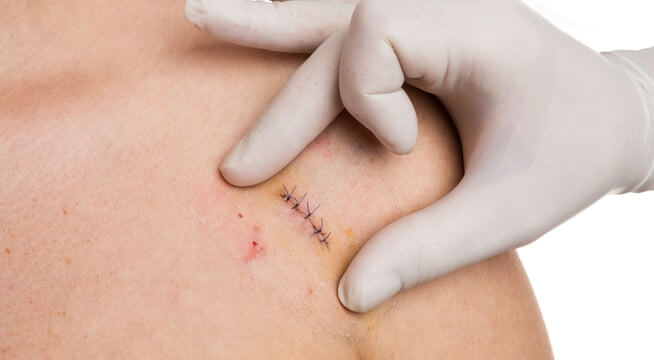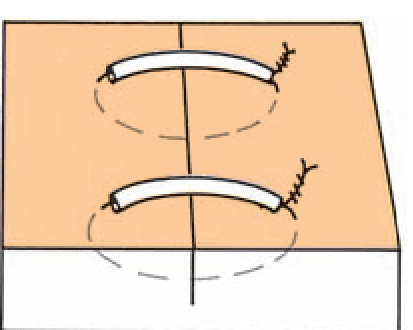Stitches are commonly used to close wounds. They can be used in many different types of surgeries, for example, cesarean sections, hernia repairs, and orthopedic surgery. At the ending of a surgical operation, nurses often remove sutures from the patient. This is to keep the wound clean and prevent infection. The process can be done by hand or using a unique instrument called a “suture removal instrument.”
Nurses are often responsible for monitoring and caring for patients during the recovery process, including removing stitches. There are two kinds of stitches: nonabsorbable and absorbable. The stitches of absorbable dissolve on their own over time, while non-absorbable sew-up requires to be detached by a doctor or clinician.
What’s the Purpose of Stitches?
Medical stitches are worn to secure cuts, wounds, and other injuries on the body.
A medical stitch is a small piece of cloth that has been stitched together to form a solid thread-like material used for suturing.
Stitches are often referred to as surgical staples in the United States. They are typically made from polypropylene or polyester with an outer coating of stainless steel wire.
The primary purpose of medical stitches is to reduce bleeding and speed up healing time by acting as temporary bandages. It keeps the wound open to heal without being covered by scar tissue.
Stitches vs. Sutures
Stitches are a form of wound closure that uses a needle and thread to close an open wound. On the other hand, Sutures are a form of wound closure that uses a needle and thread to close an open wound. They are typically stronger than stitches and can be used to sew up wounds cut open.
Stitches are worn to close a wound or incision and provide support. Sutures are used to repair damages by holding the edges of the skin together so that healing can take place.
Sutures are typically made from synthetic materials like nylon, polyester, silk, or other natural materials such as animal hair or plant fibers.
Stitches tend to be less expensive than sutures, but they require stitches removed after a certain period has passed.
Do Nurses Learn How to Suture in Nursing School?

Suturing is used to close wounds that are deep enough to be stitched. The procedure involves using a needle with catgut or silk thread to stitch a wound closed. It also uses other materials like stainless steel wire, fine needles, and gut for certain situations where there is no access to material that can be threaded through the needle.
Nurses have the knowledge and skills required for suturing procedures. Still, they may not learn how in nursing school because it would take too much time and resources away from teaching other topics related to their field.
Besides, Nurses learn how to suture in nursing school. In a typical nursing program, students will take “Surgical Nursing” or “Operating Room Nursing.” This course is typically year-long and includes both classroom instruction and clinical rotations. Students will learn how to prepare for surgery, assist with surgical procedures, provide post-operative care, and more during the course.
Some schools may teach suturing skills in their curriculum, while others will not. The determination is up to the individual schools and faculty members and your preference.
What Course Require Nurses To Remove Stitches
Nurses need to remove stitches to close wounds, so various courses will help them learn how.
- Intensive Care Nurse: This course will teach students how to assess patients who have been injured and provide life-saving interventions for those who need them the most.
- Emergency Nursing: Students will learn about the dangers of traumatic injuries, respond appropriately when faced with a trauma victim, and identify patient responses during critical situations.
- Acute Care Nurse: Students in this course will learn about caring for critically ill patients and understand when to call an ambulance or contact their doctor before anything else is done. Suppose they are unsure what else can be done first.
Can Nurses Remove Stitches?
Nurses are highly trained professionals who have the knowledge and skills to administer many treatments. They can provide relief from pain, control bleeding, monitor vital signs, and perform various procedures.
Nurses are the spine of the medical field, providing vital care before, during, and after surgical procedures. Some nurses perform these duties with great success, while others may struggle with the tasks. Like any other profession, education and experience will determine the level of competence in their role.
Older nurses who have worked in the profession for more than ten years are generally recommended to remove stitches due to their skill and superior eyesight.
A nurse can remove stitches that have been placed in a wound to stop the bleeding or prevent infection. However, nurses should let medical professionals do this procedure because they are experts in handling these situations.
Types Of Stitches That The Nurse Can Remove

Some patients cannot take the pain and suffer from pain due to their injury or medical condition. The nurses are highly trained to reduce the patient’s pain and make them comfortable for their healing process.
But sometimes, certain situations require nurses to remove stitches on patients. It is a great relief if nurses can treat you, and you will not feel pain at all.
Here is a list of stitches that the nurses can remove.
Cotton stitches
There is a different type of stitch called cotton. After an injury, you can get it from the doctor or any other practitioner. It is a stitch that has been used before to stop bleeding.
Suture
A suture is also known as stitches, but it has a long thread. A suture is mainly used when the blood flow is not stopping. This can be due to a wound or bleeding. But, the future doesn’t cause pain at all.
Silk stitches
Some people have silk sutures that may be used for stitching. You can also get this type of stitch from your doctor. It is best for long-term use.
Removal of sutures
Removing sutures is mainly done for medical purposes. If you have a specific injury and a suture around it, the nurses will remove that suture on your own. They will remove it very carefully as it will not harm you in any way.
What about me?
As I said, certain wounds need stitches, and some of them can be removed by the nurses. So, if you are mourning from any of these wounds, you don’t need to be worried at all. The nurses will remove the stitches from you.
Conclusion
In conclusion, nurses can remove stitches and be the first line of defense for other healthcare professionals. As nurses, we need to know that we can perform this procedure and do our patients a service by taking care of this for them. So, do you want to know more about your stitches? These are the most common stitches that the nurses can remove. Now it is time to decide which kind of stitch needs removal.
 Nursing Trends
Nursing Trends







